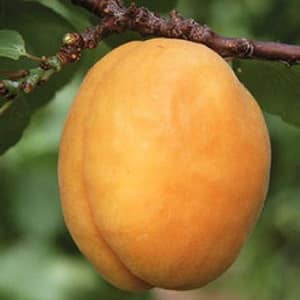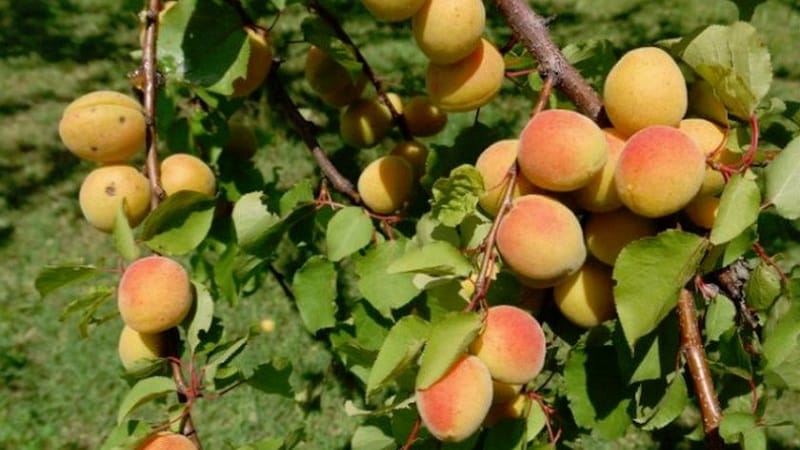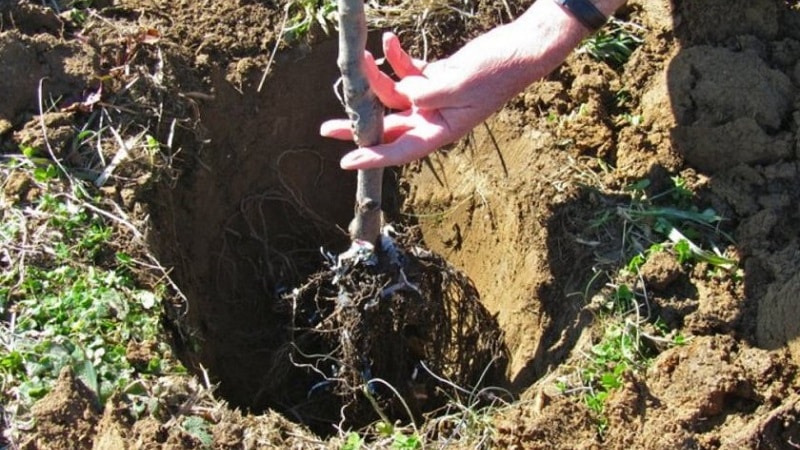Apricot Sibiryak Baikalova: variety description, cultivation features, reviews
Apricot Sibiryak Baikalov is the result of the work of Honored Agronomist of Russia Ivan Leontievich Baikalov. Thanks to the efforts of the breeder, residents of Siberia were able to grow heat-loving crops in their region. The variety is characterized by high winter hardiness and productivity. The fruits are attractive orange in color with a bright blush and have a pleasant sweet and sour taste.
Description of the variety Sibiryak Baikalova
Sibiryak Baikalova is a promising apricot variety, bred by I. L. Baikalov in 1979. All varieties of Baikalov: Golden Siberian, Gift of Nature, East Siberian, Mountain Abakan, Pride of Khakassia, Sayan.
The culture was tested in the garden of the Research Institute of Agrarian Problems of Khakassia. To the State Register the variety was included in 2002 with permission for cultivation in the East Siberian region.

The variety is characterized by frost resistance and the ability to produce high yields. after long winters with severe frosts. Temperature fluctuations do not affect the formation of ovaries.
Characteristics
Features of the variety:
- tall trees - 3–3.5 m;
- the crown is thick brown, round in shape, reaches 4 m in diameter;
- young shoots of a reddish hue;
- high ability to restore damaged shoots;
- fruit buds appear on 2-3-year-old wood and form bouquets of 2–5 buds each;
- the rest period is short;
- flowering - May 9–13;
- white-pink flowers, medium or large;
- leaves are rounded, with jagged edges, the outer side is dark green, the back is light green;
- foliage is high;
- medium-sized stalk of green color;
- the branches are strong and straight;
- the beginning of fruiting - 4 years after planting;
- fruits appear on 2-3 year old branches;
- self-sterility requires planting pollinator varieties (Sayan, Gorny Abakan);
- yield - 23–25 kg per tree;
- Harvest - end of July - beginning of August;
- fruit shelf life is low (2-3 weeks);
- the level of transportation is average.
Description of fruits:
 weight - 25–37 g;
weight - 25–37 g;- flat-oval, elongated shape;
- the skin is dense orange, with thick fluff and a continuous blush;
- the pulp is juicy orange;
- the stone is easily separated, the kernel is without bitterness;
- taste sweet;
- aroma is average;
- proportion of dry matter - 16%, sugars - 7.1%, acids - 2.4%, vitamin C - 8.1 mg/%, pectin - 0.57% per 100 g;
- universal purpose.
Fruit size depends on seasonal weather conditions: the more sunny days, the larger the apricots.
Advantages and disadvantages
Advantages of the variety:
- rapid recovery of shoots;
- frost resistance - up to -40°C;
- the plant is not prone to thickening the crown, therefore forming pruning is performed 1 time every 2 years;
- tasting taste score - 4.8 points;
- universal purpose of fruits;
- ease of care.
Flaws:
- low resistance to diseases and insects;
- the need for additional pollination;
- freezing of fruit buds.
Interesting things on the site:
Features of growing the variety
The variety Sibiryak Baikalova bears fruit consistently and annually pleases with a rich harvest. To ensure optimal conditions for the growth and development of trees, it is important to choose the right planting site. The culture takes root in areas protected from gusty winds, so it is planted on the south side, near outbuildings and houses. This will protect the plants from the cold wind and provide a high level of light.

The variety prefers fertile soil with a loose structure, neutral or slightly alkaline pH and low groundwater levels (not higher than 3 m). Before planting, acidic soil is limed by adding 400–500 g of slaked lime per 1 m². Clogged and heavy clay soil is lightened with river sand (10 kg per 1 m² for digging).
Planting pits are prepared in advance: a hole measuring 70x70x70 cm is dug in the area, the soil from the hole is mixed with humus and superphosphate (30 g per 1 m²), wood ash (200 g) and backfilled. Prepare holes in the fall, during spring planting, and in the spring, in autumn.
Advice! If you purchased the seedling too late and did not have time to prepare the planting hole, bury the young tree in the trench. This will make it easier for the plant to survive the time before planting in a permanent place.
The seedling is lowered into the prepared hole and covered with earth to the level of the root collar, without deepening it. Make a watering circle along the diameter of the hole and pour 20 liters of clean water into it.
Gardeners also practice horizontal planting of apricots.. The young seedling is bent to the ground and secured to the branches at an angle of 40°. This provides the young tree with warmth from the ground.

Apricot care
The crop does not tolerate excess moisture in the soil and needs moderate watering. The tree trunk circle is watered once every 2 weeks. During the rainy season, watering is stopped.Installing a drip irrigation system can reduce labor costs, especially when growing trees in large quantities. Plastic or metal pipes with watering drippers are laid on the site and water is supplied by gravity or under pressure. At the same time, water should not get on the tree - this threatens to reduce the yield due to leaching of pollen.
Top dressing
Apricot needs regular feeding. Mineral complexes are applied in spring and autumn, organic complexes - in early spring and before flowering.
Reference. The preparations “Iskra Bio”, “Agravertin”, “Healthy Garden”, “Akarin” increase the plant’s defenses and eliminate the need to use insecticides against insects.
Add organic matter before flowering: 500 ml of chicken manure solution per 10 liters of water. The product is watered around the tree trunk. After 5 days, 1 liter of wood ash is added to the soil to prevent acidification.
For proper formation of fruits after flowering, trees are fed with potassium and phosphorus.: 40 g of potassium sulfate, 40 g of superphosphate, 60 g of urea are diluted in 10 liters of water. Fertilizer is applied to the tree trunk area. After a week, add 1 liter of wood ash.
Falling ovaries indicate excess nitrogen in the soil. During the period of ovary formation, trees are fertilized with a nutrient solution: 30 g of superphosphate and 30 g of potassium sulfate per 10 liters of water.

Wintering
Before wintering carry out moisture-recharging abundant watering of trees and mulch the tree trunk circle with spruce branches, tie the trunk with burlap or synthetic material to prevent damage to the bark by rodents. In winter, the snow cover is constantly trampled down. In February, the trunks are tied with white non-woven fabric to protect the bark from sunburn.
Crown molding
Tierless crown molding is considered one of the best for apricots. It assumes the presence of 5-6 main branches located at intervals of 40 cm. The procedure begins at the age of 1 year from the moment of planting. If there are no branches, the seedling is pruned after spring planting at a level of 80–90 cm. If there are lateral branches, select 2 along the row and shorten them by half. The rest are cut into a ring.
The central conductor is shortened by 20–25 cm above the lateral branches. In summer, shoots growing at an acute angle are removed. Subsequently, 3-4 more main branches are laid, on which branches of the second row are formed with an interval of 35–40 cm. It is important to constantly monitor the growth of shoots and not allow the upper ones to outstrip the lower ones.
Excess shoots are shortened and turned into overgrowing fruit shoots.. Once the last main branch has been identified, the central conductor above it is cut off next spring.

Disease and pest control
Apricot Sibiryak Baikalova is susceptible to attacks by insect pests. The fruits become food for moths and sawflies, and the leaves are eaten by aphids. To destroy them, insecticides are used: “Aktaru”, “Match”, “Mospilan”, “Prokleym”, “Omite”.
The variety is susceptible to moniliosis, or gray rot.. The infection affects flowers, bark and fruits. The cause of the disease is the Monilia fungus, which penetrates through the pistil. The ascomycete grows into the peduncle and enters the branches. Symptoms: falling ovaries and flowers in May, dry branches in June, affected leaves and fruits in July. Light gray pads with dark dots called spores are visible on the bark of an infected tree. Branches and foliage change color to dark brown and dry out. Round gray spots appear on the fruits.
Favorable conditions for fungus - low air temperature in early spring and during the flowering period, high humidity. To prevent infection, trees are sprayed with Horus, Mikosan-B, 1% Bordeaux mixture, and urea solution before flowering. After this, apricots are processed 2 times in June - July and 2 times after harvest. Dry branches are cut and burned, the tree trunk is dug up, and the optimal level of calcium in the soil is maintained. The same prevention methods are used to combat perforated spotting.
Reviews
The apricot variety Sibiryak Baikalova is popular among gardeners due to its ease of care, abundant fruiting and excellent taste of fruits.

Elena, Tomsk: “We’ve been growing this variety of apricot at our dacha for about 10 years and couldn’t be happier. Fruits abundantly, but the volume of the harvest depends on weather conditions. If the summer is cold, apricots grow small and sour; if it is hot, the fruits turn out large, ruddy and sweet. Caring for trees is not difficult, the main thing is to water and fertilize on time. We use chicken manure, ash and superphosphate".
Vladislav, Kemerovo: “It would seem what apricots are like in our area, but thanks to the efforts of breeders, everything is possible. The seedlings of Sibiryak Baikalov were planted 5 years ago and we are already in full swing harvesting. Trees can withstand severe frosts when covered for the winter. I cover the tree trunk circle with spruce branches, and in winter I periodically add snow and compact it. Apricots have a pleasant sweet and sour taste and attractive appearance. With sufficient lighting, the blush completely covers the fruit.".
Conclusion
Sibiryak Baikalova is an apricot variety bred specifically for regions with cold climates.The culture is characterized by rapid shoot recovery, frost resistance down to -40°C, and a yield of up to 25 kg per tree. Tasting score of the fruit is 4.8 points; the fruit attracts with its rich orange color with a bright blush. The taste of apricots is pleasant and balanced.